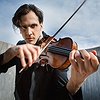Part 2
Could you take me through the process of composing on the basis of one of your pieces that's particularly dear to you, please? What do you start with when working on a new piece, for example, how do you form your creative decisions and how do you refine them?
Right now I'm working on another solo piece using the same tech I use on this record. It typically starts with a musical object that really grabs me. In this case a violin melody played through my harmonizer set-up to create accompanying harmonies. I’ll play with it for a while seeing what, if anything, it does. There are nouns and verbs in music. Sound objects are the nouns (textures, phrases, etc.) but if they don’t go anywhere, they don’t really evolve into something; there are no verbs. For an element to really be great it has to do something special, it needs some great verbs. This one led to all sorts of other places and so the music starts writing itself.
Eventually it becomes time to hunt for more sound objects and see if they too have legs to keep the story going. A lot of the time these objects might be an interesting live electronic transformation. For the piece I mentioned the second object involved this arpeggiating processing I developed. By feeding the violin into it and carefully choosing pitch sets I can create these rich polyphonic harmonies above my violin patterns.
Sometimes these objects end up in different songs than originally intended or even just remain on the shelf for another time. I’ve had to shelve a lot of fantastic music that just didn’t fit the story. That’s a particularly heartbreaking part of the job I must say.
Once there are a bunch of sibling objects the real architectural work can happen: making sure these elements flow together in a compelling way. I’m not down for works that just flip on and off, it sounds lazy to me, particularly in instrumental music; the bar needs to be higher without a built-in vocal narrative to guide you. This is the important, often dismissed work of form: making sure your music’s character is cohesive throughout and doesn’t just sound like a bunch of arbitrary non sequiturs. The more abstract your music is, the more important this is for the listener.
Additionally, there’s lots of back and forth for me building or modifying software to be able to achieve what I need to live. I don’t use backing tracks, so that puzzle is a unique part of my personal compositional challenge.
What, if anything, do you personally draw from the cosmos of electronic music and digital production tools that is inspiring for your daily practice? In how far do you see the potential for a mutual creative pollination between the two?
I have a particularly narrow interest in electronic music: what can be done live to re-contextualize live performance. Live processing allows the audience to be a witness to the process, using the same skills they would to connect to any live performance, but with some new expectations which you design. I’ve seen how gratifying that process is for an audience. Without knowing technically what’s happening, people are always coming up to me and telling me how they really enjoyed the live aspect of the electronics. A sound recording is a document of expression from another time and place far removed from the space of the show. I don’t think people really want to come to a gig to hear you play a soundfile at them, even if they’ve been trained to deal with it.
How do you see the relationship between timbre and composition?
Timbre is a compositional element that for me, like many composers, is a way of coloring in the shapes between the lines you’ve laid out. Sometimes the most beautiful aspect of a simple drawing is indeed its color. None of these elements can truly be separated of course. The same fantastic melody in a different part of the instrument will sound complete horrible. We live in a multi-dimensional space and like real-life we can’t just ignore one dimension and proceed along with the other two; you’ll bump into things and it hurts.
In addition to orchestrational choices I can access an expanded timbral palette through live digital processing of these instruments. To that end timbre is often an indicator of this process for an audience; they can make a connection to the electronic component by hearing how it has transformed the original instrument’s tone, and thus its character.
Time is a variable only seldomly discussed within the context of contemporary composition. Can you tell me a bit about your perspective on time in relation to a composition and what role it plays in your work?
Is that true? I feel like there was a bunch of scholarship on minimalism regarding its effect on temporal perception etc.
For me, time is among the most important musical topics. The ability to wield temporal nuance during a performance is critical to my music, as it is to so much expressive music. My music would die crucified if nailed to some grid.
Our own internal tactus is one of our most powerful musical assets. When we feel time tugging or slipping in musical ways it’s a form of motion as evocative as a melody moving up and down. This quality goes away for most modern BPM-bound electronic music. For dance music this works well, because you don’t want that level of sensitivity; the beat is a contract that you will always get that kick and snare where you expect. Maybe your dad left, maybe your girlfriend ran off with your mate, but that backbeat will always be right there where you left it. I love a lot of dance jams but I’m just not into signing up for those psychic terms myself. Part of the ritual I’m trying to lead you through involves reclaiming time for ourselves as a personal object.
What do improvisation and composition mean to you and what, to you, are their respective merits?
I think it was Bill Frisell who said that improvisation is like composing in real-time. I’ve always connected with that sentiment in the sense that I like my compositions to flow forward “naturally”, which you sort of get for free when improvising. A composition evokes a character and the story that character tells should be believable. Even if the character is a madman, madmen act a particular way according to their nature.
I use improvisation to generate material that I later refine into parts that make their way into compositions. I do a lot of playing, often at the piano, while I compose, basically improvising on ideas I’ve already got in place. It’s the best way I know to see if things really work; by checking my gut as I play and listen.








